‘Desktop virtualization’ has been an oft-heard phrase over recent years, but talk does not automatically translate into action. So what is the state of play regarding deployments of the many desktop virtualization alternatives that exist?
Earlier this week we requested your input, and here’s what we have found out so far.
It is worth noting first that as with all online polls, the respondents were ‘self-selecting’, which means that the data collected represents a proportion of those with a particular interest in, or knowledge of the topic. Interestingly, the number of respondents for the desktop virtualization survey is just over a quarter the size of those who gave feedback on x86 Server virtualization. This alone may indicate that overall levels of understanding and experience in desktop virtualization are still comparatively low.
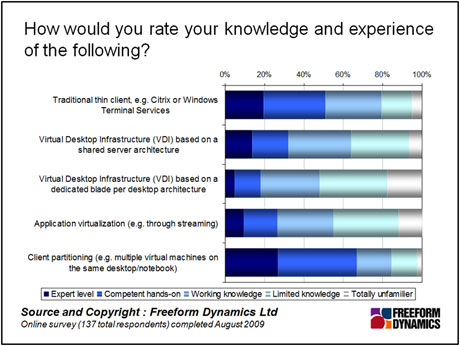
One of the most immediate issues surrounding “desktop virtualization” concerns the fact that it is an umbrella term for a number of alternative approaches that happen to offer similar results. The chart above illustrates that amongst our respondents at least, there is quite widespread knowledge and experience of traditional thin client mechanisms, and solutions that enable multiple virtual machines to be run on a single desktop. Let’s be clear: these two are not equivalent approaches, but it is important to note the breadth of this apparently simple domain.
Another fascinating return concerns that more respondents rate themselves as ‘expert’ or having ‘competent hands on’ knowledge of VDI based on shared server architectures rather than on a dedicated ‘blade per desktop’ model. Once again this may reflect the overall state of play and maturity of the market; conceptually at least, shared server models are more complex.
Unsurprisingly, as shown in the second figure deployment of desktop virtualization solutions largely reflects knowledge levels, but it is interesting to see how newer models, such as VDI and application streaming, appear to have significant numbers of pilot projects or selective rollouts planned or under way.
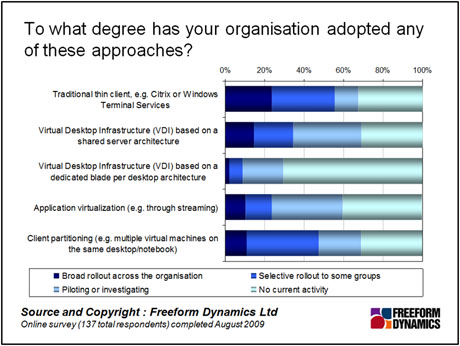
Turning attention to the needs of different user groups, for virtualized desktops it seems that few such groups are entirely out of the question, with the sole exception of the ‘creative’ workers with resource-intensive performance requirements. As the figure below shows, overall general office and transaction workers, long the mainstay of thin client deployments, top the list of users thought to be best suited to virtual desktops with IT support and development staff also high up the list.
It is interesting to note that the ‘mobile worker’ and ‘office based power user’ categories attract considerable attention as potential users of virtualised desktops as these users have traditionally not been seen as suitable candidates for thin client offerings.
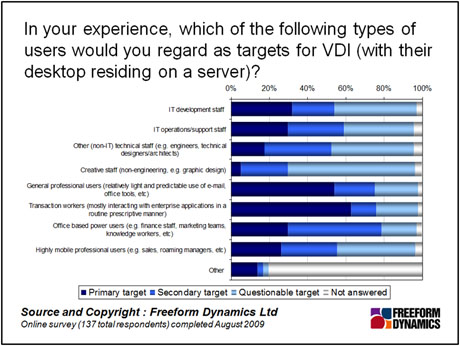
A point to note is that while view of ‘actual’ desktop virtualization deployment across different user categories overlaps with the above, as we see in the following figure it is within IT that it is more likely to be deployed.
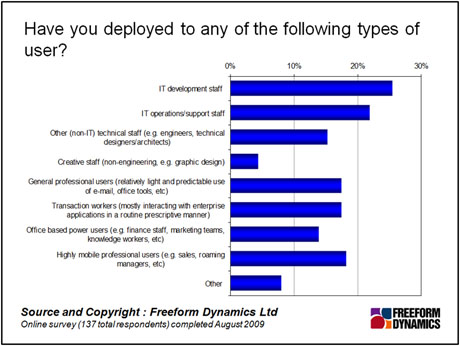
When it comes to barriers to the adoption of virtual desktop solutions, the main factor appears to come down to ‘cost’ – which is interesting (as the implication is fewer are questioning the need). Close to the bottom of the list are challenges in the areas of skills, management solutions and the maturity of the solutions.
The low profile of management challenges is interesting when looked at in the light of research we have carried out that identifies the daily management of virtualised x86 servers to be a matter of concern, and we have little doubt that this will become a bigger concern as time rolls forward.
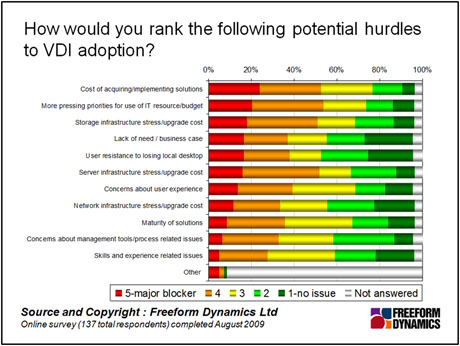
When it comes to the benefits of using Desktop Virtualization solutions, we find increased flexibility and greater security are perceived to be the most likely to be attained. Better cost profiles, happier IT support staff and lower administrative overheads are great net positives for the IT department, but with what impact?
It appears that this doesn’t equate to happier and more productive users and business managers. Or is it a case of ‘no less happy’? Most organisations would be happy with a ‘didn’t notice the difference’, we suspect.
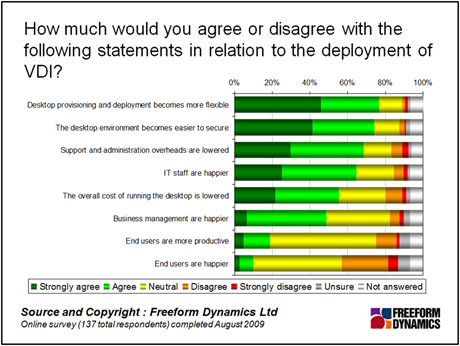
All in all it is clear that desktop virtualization (or at least many of the variations on the theme) remains in its youth. In terms of benefits and potential inhibitors it is fascinating to learn from the experience of those that took part in the survey. Their perceptions differ fairly widely from those being actively marketed by the vendor community, which is worrisome – for the vendors at least.
Through our research and insights, we help bridge the gap between technology buyers and sellers.





Have You Read This?
From Barcode Scanning to Smart Data Capture
Beyond the Barcode: Smart Data Capture
The Evolving Role of Converged Infrastructure in Modern IT
Evaluating the Potential of Hyper-Converged Storage
Kubernetes as an enterprise multi-cloud enabler
A CX perspective on the Contact Centre
Automation of SAP Master Data Management
Tackling the software skills crunch